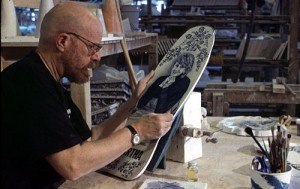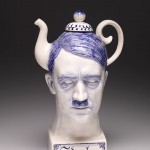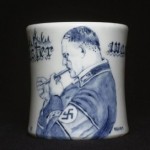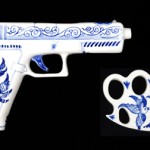 “I’ve always had a knack and penchant for going toward humorous irony.” That’s what celebrated Seattle artist Charles Krafft told Salon in a 2002 interview.
“I’ve always had a knack and penchant for going toward humorous irony.” That’s what celebrated Seattle artist Charles Krafft told Salon in a 2002 interview.
And if you were looking for irony in his work, it was easy to find. A self-taught painter, Krafft began working almost exclusively in ceramics during the early 1990s. His classically painted ceramics, coming in all shapes and sizes, were quickly and widely saluted for their artistry as well as their dark presence. His Disasterware series, for example, consisted of plates, busts, and a myriad of other delicate pieces, each commemorating historical catastrophes–from the sinking of the Andrea Doria to the firebombing of Dresden.
Then there was Krafft’s pervasive use of nazi imagery. He built teapots from Hitler’s head and put swastikas on perfume bottles.  The largely liberal West Coast art establishment ate it up, agreeing in unison that it was all ironic, that Krafft was using his craft to pan fascism.
The largely liberal West Coast art establishment ate it up, agreeing in unison that it was all ironic, that Krafft was using his craft to pan fascism.
Then last month came this story, penned by Jen Graves of the Seattle alternative weekly, The Stranger. Graves found, and reported, something that Charles Krafft had done little to hide—he was an anti-Semite and a white nationalist, whose far-right-wing thematics weren’t ironic at all.
 Krafft’s ideology seems to have evolved over time, culminating today in Holocaust-denial (or at least Holocaust minimizing), and an active presence on far-right Internet forums and podcasts. In fact, Graves says, it was just a couple simple Google searches that presaged her glimpse into Krafft’s character. He’d made no effort to hide his identity during these affiliations. One of Graves’s first finds was a podcast archived on the white nationalist website, The White Network, in which Krafft participated in a debate as to whether well-known racists should keep their darkest feelings secret. The group decided they should not.
Krafft’s ideology seems to have evolved over time, culminating today in Holocaust-denial (or at least Holocaust minimizing), and an active presence on far-right Internet forums and podcasts. In fact, Graves says, it was just a couple simple Google searches that presaged her glimpse into Krafft’s character. He’d made no effort to hide his identity during these affiliations. One of Graves’s first finds was a podcast archived on the white nationalist website, The White Network, in which Krafft participated in a debate as to whether well-known racists should keep their darkest feelings secret. The group decided they should not.
It may seem, then, that the real Charles Krafft was hiding in plain sight after all, and it’s the fault of the art-patronage establishment for not recognizing him for what he was.
Except Charles Krafft was far more duplicitous throughout his career than one might expect from his current, post-outing candor.
Take the above-depicted Hitler teapot, for example. In 2007 it was displayed in the Fine Arts Museums of San Francisco. Curator Timothy Burgard wrote a catalog description of the piece, describing it as explicitly and clearly anti-fascist. Krafft wrote to Burgard in 2008, saying “You certainly did your homework on the context” of the piece.
Or more chillingly, earlier, in 2006. Another curator asked him directly: “Do you consider yourself a neo-nazi?” Krafft reportedly laughed and said no, then—”But would that frighten you if I were?”
Charles Krafft’s talent is undeniable. His work is compelling. But his fame is based on a lie. His fame is an infiltration. His is an ideology that camouflaged itself to gain entree into a world where, in all likelihood, he would not be welcome.
So what do we do with the art of Charles Krafft? Do we smash it to bits? I don’t think so—that’s the MO of the fascists, after all. 
I say, leave Krafft’s art where it is. Go to the museums, and look upon it. Look upon it, knowing that you’re glimpsing deeply into the mind of the artist. And know that there’s nothing there ironic, nothing ironic at all.